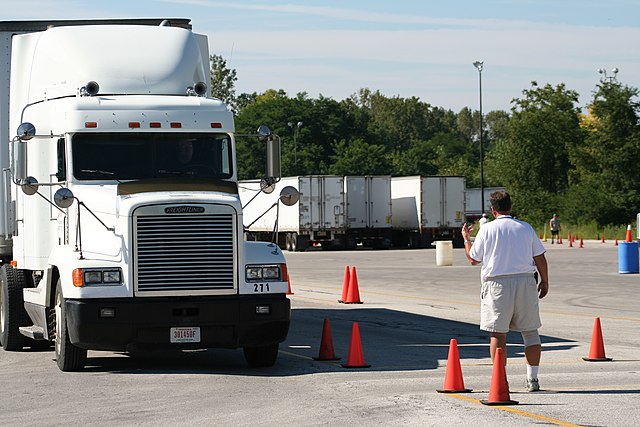Proposed revisions to Pennsylvania’s skills evaluation for commercial driver licenses are anticipated to enhance accessibility for aspiring truck drivers while maintaining road safety, as affirmed by officials overseeing local training and assessment programs.
These updated criteria will also bring alterations to the licensing procedure for school bus drivers, potentially alleviating the persistent scarcity of such drivers in the state.
Recently, the Department of Transportation of Pennsylvania disclosed its plans to introduce a modernized skills test for commercial driver licenses across all PennDOT license centers and authorized third-party facilities, commencing on August 28.
The much-needed revisions, designed to align with contemporary vehicle advancements, will impact the segments of the full skills test related to pre-trip vehicle inspection and fundamental control aptitude, according to PennDOT.
Applicants aiming for licenses will still be obligated to pass an initial written examination, and the concluding road test segment of the skills assessment will remain unaltered.
“It continues to effectively assess whether an individual is roadworthy,” commented Mike Glanz, the Director of Operations at CC Training. CC Training administers the CDL training curriculum at Luzerne County Community College in Nanticoke. Glanz was referring to the updated test’s ability to ensure road safety while evaluating candidates.
“As always, you can never test for everything, but you have to test to the point of being reasonably sure that the person knows enough to be safe on the job. I do believe this test tests to that level. It meets that criteria.”
Frank Tunis, the CDL Program Director at Fortis Institute in Forty Fort, expressed his confidence in the modifications, noting that he harbors no apprehensions about the changes. He characterized the standards as stringent and comprehensive.
“They are not giving anything away,” Tunis said. “You still have to be able to maneuver the vehicle.”
Nonetheless, these adjustments will contribute to a more efficient and uncomplicated testing process, he explained.
As an illustration, in the existing pre-trip inspection assessment, a candidate might be tasked with recognizing over 120 distinct components on the vehicle and elucidating the safety-related aspects they are inspecting, in order to ascertain its operational soundness, he elaborated.
However, with the revised criteria, this quantity will be reduced to approximately 90 components. Moreover, PennDOT specifies that under the fresh guidelines, applicants will have the liberty to employ a checklist as a mnemonic device.
“So as you go through, instead of the examiner having a checklist and you trying to do everything by memory, you’ll have a checklist to help you,” Tunis said. “It won’t give you the specifics of every part, but it gives a generalization of what you’re looking for.”
In a similar vein, the existing basic control skills test primarily evaluates the operator’s aptitude for backing maneuvers, according to Glanz. However, the updated test will demand candidates to execute four distinct maneuvers that showcase their command over the vehicle: forward stop, straight-line backing, forward offset tracking, and reverse offset backing.
Glanz elaborated that the forward stop maneuver, where the driver needs to pull forward and bring the vehicle to a halt within a 3-foot designated area, was introduced due to concerns about rear-end collisions. This addition was made in collaboration with industry experts, as advised by PennDOT.
Furthermore, the current control skills test, which applicants currently perform as separate steps, will transform into a continuous, seamless maneuver. This will eliminate the need for transitions between different locations during the test.
“It’s very much a flow up and then back, and then up and then back,” Glanz said.
Tunis mentioned that these modifications are anticipated to enhance the efficiency of the CDL licensing procedure, aligning with one of PennDOT’s stated objectives.
“It’s something people can get into, understand a little easier, get through the testing process smoother, ultimately getting people into the workforce a little faster,” he said.
Another alteration is tailored to individuals aspiring to become school bus drivers.
In line with a federal exemption endorsed by PennDOT, those aiming to acquire a school bus endorsement are no longer obligated to complete the section of the CDL pre-trip inspection assessment that involves identifying engine components located “under the hood.”
“It’s a beginning. It’s certainly a beginning,” remarked Joe Stafursky, who holds the position of Operations Manager at DKB Transportation in Jermyn. DKB Transportation provides bus services to both the Valley View and Mid Valley school districts.
Given the increasing challenge of finding school bus drivers with each passing year, Stafursky expressed his positive reception of any alteration that simplifies the process for license applicants.
According to Aaron Sepkowski, President of Pocono Transportation in Covington Township and Vice President of the Pennsylvania School Bus Association, school districts across Pennsylvania currently face a shortage of approximately 3,500 drivers. However, he indicated that the actual figure is likely higher when accounting for transportation needs related to extracurricular activities.
The issue stems from school buses being categorized within the same class as tractor-trailers under Pennsylvania’s CDL licensing framework, even though these vehicles have distinct purposes and functions, as highlighted by the source.
According to Sepkowski, the Pennsylvania School Bus Association (PSBA) envisions a future where a dedicated CDL licensing procedure for school buses exists, one that can be customized to precisely meet the requirements of the student population. He expressed confidence that this proposal could garner backing within the Legislature.





